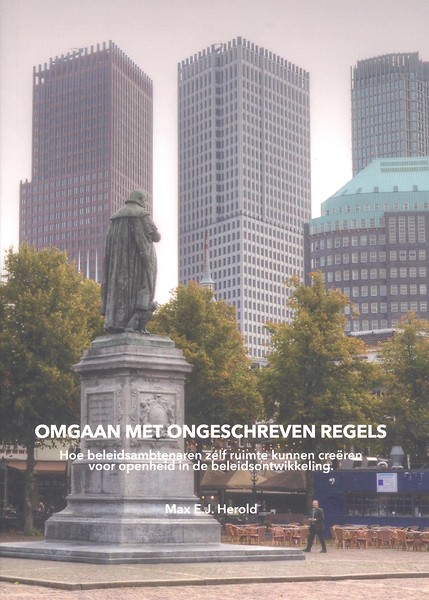Edmund Burke, an English politician who lived some two hundred years ago on the eve of the Industrial Revolution, once said: a country that does not have the means to change, also lacks the means to insure its continued existence. One would say that's very true. True not only for countries, but of course also for organizations. Continued existence is (being able to) change. Still there is something peculiar about this truth, as Peter Scott Morgan states in his book, 'The Unwritten Rules of the Game':
"We are able to process complex numbers and words in a computer the size of a book, we communicate by telephone with the other end of the world, we can safely fly tens of millions of people from one continent to another, we can eradicate deadly diseases; but as soon as we talk about making changes within the well defined and well controlled restrictions of a business community, nobody seems te be able to accomplish this and some people are starting to accept the inescapability of this."
Some, however compare an organization with a living organism. Therefore if you want to change an organization, you will make contact with, or learn from, people ('organisms') who have succeeded in changing. An example hat aids us with this and by which you can look upon individuals and organizations from the same perspective, is the Neurological Levels model of Robert Dilts.
This model is made of six levels, or rather, fields of interest:
Mission
Identity
Values
Capabilities
Behaviour
Surroundings
In change all levels play a part. Not to give any attention to one particular level means there's a fair chance that the process of change is doomed to fail. It is true, however, that changes at the higher levels impact far more. For instance if you change your Identity, it is likely that you will consequently alter your Behaviour.
Nevertheless it sometimes works the other way round – ie: a lower-level change affects a higher level. Like when a secretary I know succeeded in fulfilling a task (level of Behaviour) which she never knew she was able to accomplish. The effect of this was that she started to think much more positively about herself (change at the levels of Identity and Values). Within three months she had the job she wanted and….. the boyfriend of her dreams.This is also a good example of the connecting interaction between the levels. Speaking of connection, let's focus a little on the levels and their interrelationship.
What is a good Mission?
Mission and Vision. You rarely come across a book on strategic thinking and change, in which these words are not mentioned. Many organizations, national and international, formulate their own Mission Statements, containing a Mission and a matching Vision.
A Mission indicates what an organization's raison d'etre is and is also referred to as the soul, or the heart of the organization. This is the reason why organazations with Missions that are really supported by the employees are all called 'spirited organizations'. As all the employees of such organizations can be made to move in the same direction, there is not so much need for many rules and guidelines – a nice incidental circumstance in a time where organizations wish to become more flexible.
A Vision is an addition to a Mission. A Vision shows a little more specifically the ultimately desired situation. With many organizations the formulated Mission remains just a piece of paper without real effect. Still there are exceptions. Every now and then an organization succeeds in touching its own heart by making a formulation in such a way that it really contributes to better functioning.
Some years ago, the drilling-machine department of a large company had sales difficulties. They had as a Mission: "We make the technically best drilling machines in the world." A nice description that however had no real effect. Until one day an employee came to realise that they did not make drilling machines, but: "holes – we make holes!" This led to people starting to think about where their customers made these holes. And so they figured that it is in places where there are no electric points. This resulted in the development of the cordless drilling machine. A "hole" in the market!
A good Mission-formulation contains the following characteristics:
- the formulation as it were from the point of view of the customers/target groups (ie: externally directed).
- the formulation is positive (you point at what you do want and not at what you don't want).
- the formulation is short/simple
- it shows an added value.
- it makes you feel that by being loyal to the mission you make a responsible contribution to the larger unity.
- the formulation starts with "we" and is therefore not just an empty phrase but connected to yourself.
It is also sometimes stated that such a description is not distant, but it 'tingles' and appeals to the employees. Another example of such a Mission is Walt Disney's. He made his employees realise the Mission: "We make people happy".
Who am I?
Apart from Mission, Identity is important. Identity often describes the basic skill of a company and is more internally directed. For example I can say: "I'm a cobbler" – and my mission can be: "To keep peoples' feet warm".
Incidentally, the difference between Mission and Identity is not always very clear. For example there's the story of Mary Follet Parker who advised customers of her Identity description: "We are makers of curtains". But to customers curtains may be a part of controlling the amount of light. To look upon light-control as an essential basic skill, new possibilities were created for this company – for instance, making and selling lampshades. To play with Identity and Mission gives an answer to the question: "What business are you really in?" And that is the first question that needs to be answered in any process of change.
Often it is at Identity level that reluctance to change is rooted.
A steel factory in America laid off a number lathe operators but offered them the opportunity to train in an an equivalent skill for which there was a need. The training was started but the lathe operators refused to join in. Many of them fell into an Identity crisis. The company decided to bring in a number of psychologists to find out what was really the problem with these emplyees. It appears they defined themselves like this: I "I am a lathe operator." Being skilled up for a new job meant a loss of Identity and a great emotional uncertainty as to who they were. This would probably have been less problematic if they had identified themselves with a description like: "we are material processors", of which lathe operating can be seen as one sub-set of skills.
Values
After Mission and Identity descriptions, the next question arises. What is important to form the Mission and the Identity further? Which Values do we have to bear in mind? As the Mission is customer-orientated and Identity is more internally-aimed, one can also distinguish two kinds of Values.
On the one hand there are Values from the customers' points of view that you have to bear in mind if you want to realize your Mission. The Values that determine the relationship with your customers. Call them the external Critical Sucess Values (CSV). These can be Values like speed of deliverance, quality, innovating image, and external cooperation. On the other hand there are the internal organizational Values that have to be paid attention to, if you want te realize the Identity and Mission. To find the internal Critical Success Values, you answer the question: what has to be good within our organization if we want to realize the Mission? These can be Values like flexibility and internal communication.
It's important not to define too many external and internal CSVs but to look for "the difference that makes the difference" – the Values that can really make a difference in the functioning of the organization in the future. Therefore you could make it a rule not to define more than five external and five internal CSV's. Besides there are a few more questions of importance.
– what exactly do we mean by the respective CSVs?
– are there any unwanted side-effects to be expected?
– can we conclude that a CSV has reached an acceptable level ('proof')?
By trying to find the answer to the first question a joint image is created. That way everybody gives the same meaning to a CSV. Everybody is going in the same direction.
The second question about unwanted side-effects is connected to the first question. Let me make this clear with an example. A manager like this one has prompted the Value 'quality' to his organization by insisting with his employees that everything had to be done right the first time. He demanded this to prevent dissipation. The research department however, interpreted this as "You are not allowed to make a mistake". The result was a block of creativity and consequently a stagnation of the development of new products. In situations like this one has to be alert.
The second question draws attention to a possible resistance, that can be observed with regard to Values and convictions. If you define new values and wish to introduce them, you encounter resistance. Often it can be a good idea to try and detect this resistance. This is a way of saying: "What convictions (written)/unwritten rules) stop us from further building up our organization with these new Values?" Then it helps to make these restricting convictions debatable.
Later in this article the third question will be discussed: How do I know that a CSV has reached an acceptable level?
Skills
You could call Mission, Identity and the according Values, the "mental set" of an organization. 'Mental set' is a concept that has become known mostly through P Senge's books about learning organizations. But merely defining your mental set does not suffice. Suppose an organization has as CSV 'directed to the future'. This presumes that its employees are capable of future-aimed thinking. And many people think that a skill like that is a standard-capacity with everyone, just like speaking or walking. This is almost the same as supposing that anyone that can ice-state well, can also automatically play the piano well. Alas, that is a fiction. Crucial therefore, is to answer the question: What do Mission, Identity and according CSVs, presuppose to be necessary Skills?
This question is also crucial for success in a process of change. In introducing Mission, Identity and CSVs, you create certain expectations with the employees. If you don't let the adjoining Skills grow with the expectations that have been created, it is possible that the performance will be ultimately less succesful than it was in the beginning.
Behaviour
You could react to my story this far: "Fine, all these levels you talk about, but: how do you translate them to definitely perceptible behaviour in an organization?" When we take another look at those levels, you could say that CSVs are like steps to reach the definite activities. Actually CSVs are the spearheads of your organization policy.
Key question to be answered at level of behaviour:
"What can a particular task contribute to the CSV's that are found?"
Suppose 'openness' is found to be a CSV and one considers the tasks that contribute in a certain professional field to archievering this 'openness'.
Let's take three Personnel tasks: recruitment and selection, evaluation and payment. You can ask: what can recruitment and selection contribute to openness? This could be for example an adaption of your introduction-procedure in a way that newcomers are confronted with more different aspects and parts of the organization. It could also be to include openness as a criterion in the selection. What can evaluation contribute to openness? For example adjust the evaluation system and add openness as an extra factor.What can job-evaluation contribute to openness? For instance striving for more general job-descriptions in order to reduce 'territorial' Behaviour.
Environment
Finally we get to the Environment, to make the circle round. If you define Mission and Identity, you automatically implicate the most important target group in your Environment. Therefore it is advisible to consider the following:
- In view of the future are we to enter into new relations that are important to realise our Mission?
- Are there any present relations that had better be reduced or dismantled?
The answers to these questions can even be accentuated by the following questions:
- Are there any advantages to the present situation which we will lose if we change our relation-pattern?
- Will there appear any (unexpected) disadvantages?
- Next can you have a reconsideration of activities?
- How exactly do we create an added value to these (separate) relations?
What you measure is what you get!
Of course it's a good thing to define Mission, Identity, CSVs and project. But it's also useful to see how an organization develops on Neurological Levels. To do this you need to measure progression. The most simple method to do this is to formulate a number of indicative questions for each CSV and from time to time let them be answered by employees. In doing this you do not only measure these important Values, but also bring them to people's attention – more or less – permanently.
Final Remarks
First of all I have a few remarks in the direction of organization managers who want to start working with the system I have just explained. The management needs to do a few things. First of all, and this may be clear, the management needs to commit to the process of change for the full hundred percent. This means, on the other hand, continuing to stimulate employees to develop and practice ideas that help CVS move to a higher level.
Then it is important to find the CSVs as much as possible, in cooperation with the employees. This is to extend the Values base as far as possible.
Another thing is that you can also work on Neurological Levels in a section or as a management team in order to bring more congruency in your way of working.



